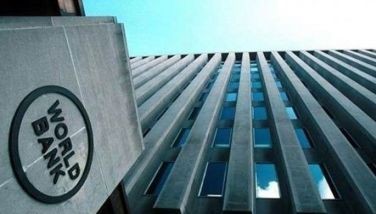Caltex closes refinery
September 24, 2003 | 12:00am
Caltex Philippines Inc. will close down its 49-year old refinery in Batangas to give way to a P750-million world-class finished product import terminal, company officials said yesterday.
"This conversion will transform Batangas into a regional supply and distribution hub where 100 percent of our products will be imported and then distributed throughout the Philippines," Caltex country chairman Timothy Leveille said.
Leveille said the plant conversion will not affect local supply or domestic oil prices. Caltex, a subsidiary of US multinational Chevron Texaco Corp., accounts for a 20 percent share of the Philippine oil industry.
The new terminal, Leveille said, will have a storage capacity of 2.7 million barrels of finished products, bringing the total product storage capacity of the oil firm to over four million barrels representing over 65 days of Caltex’s current sales volume.
He said the new storage facility will translate into more investments on the part of Caltex. Last year, the company pumped in about P1.2 billion for its expansion and modernization program.
The Caltex official also pointed out that the move should not be construed as a "lack of confidence" in the country. "Maintaining reliable supply is one of our core commitments. Alternative import arrangements are in place. It is business as usual for all of you," he said.
Leveille said 180 of the total 220 employees in the refinery will be displaced by the conversion but will be given an ample severance pay package. Caltex has over 800 regular employees nationwide.
Energy Secretary Vincent Perez said Caltex’s decision to change its strategy in the local oil industry did not come as a surprise, although he said this would not be a precedent for the other oil refiners Petron Corp. and Pilipinas Shell Philippines Inc.
"The DOE has been anticipating this move for sometime now. They have been in the country since 1954 and it runs a modest and smallest refinery," Perez said.
Perez said the strategy of Caltex is what the country needs right now. "We need additional storage facilities. Our vision in the oil sector is to make it a regional oil storage hub like Singapore," he said.
He added they will look into the issue of whether Caltex should be obliged to undertake an initial public offering (IPO).
"Under the Oil Deregulation Law, only oil refiners should list. Since Caltex is not anymore a refinery, we cannot compel them to offer its stocks to the public. But we have to coordinate with other agencies if there are other provisions or law which may require Caltex to list," Perez said.
According to Leveille, they have considered several factors before making such a decision. These include the immediate and long-term impact and viability of readily available surplus finished products throughout Asia Pacific region; the changing marketing landscape in the Philippines; Caltex’s adjustment to a deregulated environment and; the technology limitations and investments required for the Batangas refinery to compete with much larger and more modern offshore manufacturing facilities.
"Our Batangas refinery was exposed to import competition from these larger and more efficient offshore refineries which significantly eroded our refinery’s economic viability. Today, it costs us more to manufacture our products at Batangas than it costs our competitors to import theirs," Leveille said. Roughly 90 percent of the total operating costs of the company are related to the finished products.
He noted that the Batangas refinery’s capacity of 72,000 barrels per day is too small, representing less than 0.4 percent of the refining capacity available in the Asia-Pacific region.
Batangas ranks 121st in terms of capacity and 112th in terms of technical complexity compared to other refineries in the Asia-Pacific and Middle East regions. In 2002, Caltex imported over 20 percent of its gasoline and diesel requirements.
The Caltex executive also said deregulation has forced all oil companies to continually adapt their operations and work harder to provide consumers with the best value for money.
"Caltex is not afraid of competition. It has indeed operated and done well in many other countries with deregulated markets. But to do so effectively, we must constantly make every effort to manage our costs to stay competitive and thrive in this dynamic and ever changing environment," Leveille said. "In the marketplace, the new players today control roughly 14 percent of the market and are a threat to Caltex."
Caltex corporate communications manager Marian Catedral said they have an inventory in the refinery that could still last up to first week of November. "The conversion process will probably start by the end of the year," she said.
"This conversion will transform Batangas into a regional supply and distribution hub where 100 percent of our products will be imported and then distributed throughout the Philippines," Caltex country chairman Timothy Leveille said.
Leveille said the plant conversion will not affect local supply or domestic oil prices. Caltex, a subsidiary of US multinational Chevron Texaco Corp., accounts for a 20 percent share of the Philippine oil industry.
The new terminal, Leveille said, will have a storage capacity of 2.7 million barrels of finished products, bringing the total product storage capacity of the oil firm to over four million barrels representing over 65 days of Caltex’s current sales volume.
He said the new storage facility will translate into more investments on the part of Caltex. Last year, the company pumped in about P1.2 billion for its expansion and modernization program.
The Caltex official also pointed out that the move should not be construed as a "lack of confidence" in the country. "Maintaining reliable supply is one of our core commitments. Alternative import arrangements are in place. It is business as usual for all of you," he said.
Leveille said 180 of the total 220 employees in the refinery will be displaced by the conversion but will be given an ample severance pay package. Caltex has over 800 regular employees nationwide.
Energy Secretary Vincent Perez said Caltex’s decision to change its strategy in the local oil industry did not come as a surprise, although he said this would not be a precedent for the other oil refiners Petron Corp. and Pilipinas Shell Philippines Inc.
"The DOE has been anticipating this move for sometime now. They have been in the country since 1954 and it runs a modest and smallest refinery," Perez said.
Perez said the strategy of Caltex is what the country needs right now. "We need additional storage facilities. Our vision in the oil sector is to make it a regional oil storage hub like Singapore," he said.
He added they will look into the issue of whether Caltex should be obliged to undertake an initial public offering (IPO).
"Under the Oil Deregulation Law, only oil refiners should list. Since Caltex is not anymore a refinery, we cannot compel them to offer its stocks to the public. But we have to coordinate with other agencies if there are other provisions or law which may require Caltex to list," Perez said.
According to Leveille, they have considered several factors before making such a decision. These include the immediate and long-term impact and viability of readily available surplus finished products throughout Asia Pacific region; the changing marketing landscape in the Philippines; Caltex’s adjustment to a deregulated environment and; the technology limitations and investments required for the Batangas refinery to compete with much larger and more modern offshore manufacturing facilities.
"Our Batangas refinery was exposed to import competition from these larger and more efficient offshore refineries which significantly eroded our refinery’s economic viability. Today, it costs us more to manufacture our products at Batangas than it costs our competitors to import theirs," Leveille said. Roughly 90 percent of the total operating costs of the company are related to the finished products.
He noted that the Batangas refinery’s capacity of 72,000 barrels per day is too small, representing less than 0.4 percent of the refining capacity available in the Asia-Pacific region.
Batangas ranks 121st in terms of capacity and 112th in terms of technical complexity compared to other refineries in the Asia-Pacific and Middle East regions. In 2002, Caltex imported over 20 percent of its gasoline and diesel requirements.
The Caltex executive also said deregulation has forced all oil companies to continually adapt their operations and work harder to provide consumers with the best value for money.
"Caltex is not afraid of competition. It has indeed operated and done well in many other countries with deregulated markets. But to do so effectively, we must constantly make every effort to manage our costs to stay competitive and thrive in this dynamic and ever changing environment," Leveille said. "In the marketplace, the new players today control roughly 14 percent of the market and are a threat to Caltex."
Caltex corporate communications manager Marian Catedral said they have an inventory in the refinery that could still last up to first week of November. "The conversion process will probably start by the end of the year," she said.
BrandSpace Articles
<
>
- Latest
- Trending
Trending
Latest






















